�K�C�j�[����̃J�U�t�X�^�����|�[�g #4
�K�C�j�[����̃J�U�t�X�^�����|�[�g #4
�@�@�`�X�{ �O �u���̈ꐶ�v�`
�����|�[�g#3 �����|�[�g#2 �����|�[�g#1
| �J�U�t�̃V�[���ōŏ��̓��{�̃e�[ �}�͐X�{ �O�́u���̈ꐶ�v �Ƃ��V���[�ł��B�u���̈ꐶ�v�Ƃ��V���[�̏�����1966�N�A���}�g�C�̃J�U�t�A�J�f�~�b�N����ł����B���̃V���[�ŃJ�U�t�ŗL���ȃA�[�e�B�X�g �k�� �}�n�m �U�m�g���m (�q�Y)�\���{�m �U�m�_���x�R�� (�P�C)�ƗV�т� �����B 2�Ԗڂ̃V���[�́uChio Chio �T���v�ł��B�ŏ����̃I�y �� �Ńo�C�Z�C�g�� �N���@�Y( Chio �T��) �̂��܂����B �uChio Chio �T���v�I�y���̏����̓A���}�g�C1944 �N�ł����B���̃I�y���̐V���������̓A�X�^�i�̃A�X�^�i�I�y��2016�N�ł����B |
| ��JAPANESE THEMES ON THE KAZAKH STAGE�� MUKHTAROVA GAINI Kaoru Morimot��`s play ��Woman`s Destiny�� The first stage performance on the Japanese theme on the Kazakh scene was a play ��Woman`s Destiny�� - ��Shugustagi bir beibak�� ( ���̈ꐶ ) by the scenario of the Japanese play wright Kaoru Morimoto. The premiere of the play took place on the scene of the Kazakh State Academic Theatre named after M.O. Auyezov in Almaty, in 1966. Kazakh prominent actors such as Nurmukhan Zhantorin (in Tosiro`s role) and Sholpan Zhandarbekova (in Kei`s role) played the main characters. |
 |
| Photo �� 1. Kazakh actress Sholpan Zhandarbekova in Kei`s role in Kaoru Morimoto`s play �� Woman`s Destiny�� (1966) |
| Stage director of the play became Men Don Uk, a graduate of the Russian University of Theatre Arts (GITIS`s) producing faculty , he was a staging manager of a considerable amount of plays on the Kazakh theatre scenes from 1962-till 1968, which have been highly evaluated by the Republican and All-union theatre community. However, to a broad audience he is still well known for his famous movie`s role in ��Transsiberian Express�� (1972), where he played a role of a Japanese businessmen Mr. Saito. |
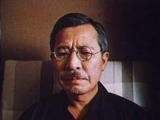 |
| Photo �� 2. Men Don Uk in the role of Mr. Saito in ��Transsiberian Express��, screenwriters: Alexandr Adabashiyan, Nikita Mikhalkov, Producing director Eldar Urazbayev,Filmproduction studio ��Kazakh film�� 1977. |
| History and plot summary of the play ��Woman`s Destiny�� In 1941 a Japanese playwright Kaoru Morimoto ( 1912-1946) wrote for the actress Haruko Sugimura a play ��Woman`s Destiny�� (���̈ꐶ), which lately became one ofherbest roles. Haruko Sugimura`s (1909 ? 1997) own destiny remotely resembles the life of her heroine - Kei, who also orphaned in early childhood. Plot of the play is about a girl Kei, who founds herself in the Shinzu house, of a successful company proprietress. An intelligent girl Kei very fast became for heranirreplaceable assistant. Soon Kei got married to the elder son of the company`s owner. Leadership in company`s guidance after the death of Shinzu goes to Kei. However,power and money gradually withered her soul and ruined her family. |
 |
| Photo �� 3. Actress Sugimura Haruko |
| For the first time the play ��Woman`s Destiny�� was staged in the USSR in 1960 on the scene of the Mayakovsky Theatre in Moscow. A producing director of the play became a Japanese actress and a producer Yosiko Okada. Her own tragic destiny was full of hardships, but at the same time, is interesting to study in the context of her professional development. |
 |
| Photo �� 4. Actress and producer Yosiko Okada |
| ��A superstar of the pre-war theatre and cinema, a participant of the giddy escape from the Stalin`s USSR, GULAG`s prisoner, Moscow Radio`s announcer, a GITIS student and a splendid actress ? such incredible turns of fate not on the stage, but in her real life has experienced Yosiko Okada. With her truly dramatic biography Okada-san showed us power and greatness of a woman, ability to overcome most incredible life hardships and challenges due to the faith in bright dreams as well as her strong will and inner power. Okada san survived a terrible tragedy ?while having a passionate wish to study from a genius Soviet staging producer Meyerhold, she decided to emigrate to the communist country. But her act indirectly leads to the death of a great theatre figure, of a person whom she greatly respected and professionally admired. Consciousness of this, tormented her the whole life. However, Okada-san stayed strong through times of hardships. She spent long ten years of imprisonment in Stalin`s camps, and after the war from the Moscow Radio studio from day to day she sent messages of friendship to her compatriots. Till the last day of her life she exerted all her efforts, directed to the enlargement and enhancement of connections among theatre figures of Russia and Japan�� ? was written by Nikolai Grankin in article ��Amazing destiny of Yosiko Okada�� Opera ��Cio Cio San�� The second stage performance on the Japanese theme on the Kazakh scene was a play Opera ��Cio Cio san�� in 1944. The world premiere of Giacomo Puccini`s ��Cio Cio san�� (Madam Batterfly) opera was at La Scala Opera stage on 17-th September 1904. In different years the part of Cio san has been performed by various world famous and prominent opera singers such Rosina Storchio, Maria Callas, Monserat Caballe, Maria Bieshu and other. From the Japanese singers, the part of Cio-san was magnificently performed by Tamaki Miura (1884), who got an excellent education abroad. She was chosen to the role of Cio san in the innovative staging of the opera by the Russian staging producer Vladimir Rosing in the framework of his season 'Allied Opera Season' in May and June 1915 at London Opera House. Lately, Tamaki Miura successfully performed this part in Boston, New York, San Francisco and Chicago. |
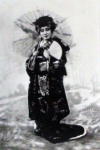 |
| Photo �� 5. Tamaki Miura in ��Cio Cio San�� |
| For the first time, on the Kazakh opera scene the legendary Kazakh singer Kulash Baiseitova performed the Cio San part in 1944. As wrote at that time a staging producer A. Troizkyi in ��Heritage of Kulash Baiseitova�� - ��When we were listening the part of Cio san in performance of a singer Kulash, we weren`t hampered by the absence of knowledge of the Kazakh language. It seem to us that we understand not only a common, expressed by the artist thought, but we had an impression that we understand and feel deeply each single word sang by her. So vividly Kulash could express and show emotions of Cio san in all her mimics and intonation��. The part of Cio San on the stage of the State Academic Theatre of Opera and Ballet named after Abai (GATOB) has been performed in different ages by numerous GATOB leading opera singers such as Rosa Zhamalova, Gulsat Dauerbayeva, Khorlan Kalilambekova, Dina Dutmagambetova and by others. |
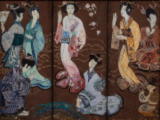 |
| Photo �� 6. Scenary to the ��Cio Cio san opera�� in GATOB named after Abai, drawn by the Kazakh artist painter Gulfairus Ismailova in 1972. |
| Merited Artist of the Republic of Kazakhstan, National Artist of the Republic of Kazakhstan, Gulfairus Ismailova drew stunning decorations to the opera ��Cio Cio san��. |
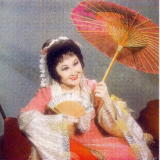 |
| Photo �� 7. Kazakh opera singer Rosa Zhamalova in ��Cio Cio San�� |
| On 15 -16 th of April 2016 in Astana Opera took place the premiere of the Opera ��Cio Cio San�� (Madam Butterfly) by Libretto of Luigi Illica and Giuseppe Giacosa based on David Belasco�fs drama ��Geisha��. The play was staged with the support of Italian partners. Stage director Lorenzo Amato. The part of Cio Cio san are performing Kazakh opera singers Zhannat Baktay and Zhupar Gabdullina. |
 |
| Photo �� 8. ��Cio Cio San�� Madam Butterfly opera poster, Astana Opera, 2016 |
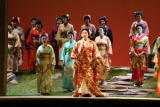 |
Photo �� 9. Scene from the Opera «Madam Butterfly». Soloist Zhannat Baktay. Astana Opera, 2016. |
| In the play were used 30 silk kimono`s prepared in Italy. Eight female and two male kimono`s as well as two ��obi-belts�� were chousen by the costume designer Franca Squarciapino from the own collection of Ms. Zhunko Kamohara, a spouse of a former Ambassador Extraordinary and Plenipotentiory of Japan in the Republic of Kazakhstan His Excellency Mr. Kamohara Masayoshi. |
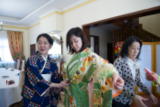 |
| Photo �� 10. Mrs. Zhunko Kamohara with a collection of kimono`s |
| Currently in Astana Opera are performing three Japanese ballet dancers Seika Tonosaki, Serina Sunagawa and Mariko Kitamura. For instance, Serina Suganawa is performing the roles in such plays as ��Romeo and Juliette��, �� La Bayadere��, ��The Fountain of Bakhchisarai��. |
 |
| Photo �� 11. Japanese ballet dancers Seika Tonosaki, Serina Suginawa, and Mariko Kitamura, who are performing in Astana Opera |
| ��`�����~���{�p�� ���u�}�p �~�p �{�p�x�p�����{���z �����u�~�u�� �M�������p�����r�p �C�p�z�~�y �R���u�{���p�{�|�� ��R���t���q�p �w�u�~���y�~���� �K�p������ �M�����y�}������. �P�u���r���z ���������p�~���r�{���z �~�p �������~���{���� ���u�}�� �~�p �{�p�x�p�����{���z �����u�~�u �����p�| �����u�{���p�{�|�� ��Y��?�������p?�� �q?�� �q�u�z�q�p?�� (��R���t���q�p �w�u�~���y�~����) (����. ���̈ꐶ), ���������p�r�|�u�~�~���z ���� �����u���u �������~���{���s�� �t���p�}�p�������s�p �K�p������ �M�����y�}������. �P���u�}���u���p �����u�{���p�{�|�� ��R���t���q�p �w�u�~���y�~���� �������������|�p���� �r 1966 �s���t�� �~�p �����u�~�u �K�p�x�p�����{���s�� �s�������t�p�������r�u�~�~���s�� �p�{�p�t�u�}�y���u���{���s�� ���u�p�����p �t���p�}�� �y�}�u�~�y �M.�O. �@�����x���r�p �r �s.�@�|�}�p����. �C�|�p�r�~���u �����|�y �r ���������p�~���r�{�u �����s���p�|�y �y�x�r�u�����~���u �{�p�x�p�����{�y�u �p�{���u���� �N�����}�����p�~ �G�p�~�������y�~ (�r �����|�y �S�����y����) �y �Y���|���p�~ �G�p�~�t�p�q�u���{���r�p (�r �����|�y �K���z). �Q�u�w�y�����u�����} �����u�{���p�{�|�� �����p�| �M�u�~ �D���~ �T�{, �r���������{�~�y�{ ���u�w�y�����u�����{���s�� ���p�{���|�����u���p �C�I�S�I�R�p, ���~ ���������p�r�y�| �}�~���w�u�����r�p �����u�{���p�{�|�u�z �� 1962-1968 �s�s. �~�p �����u�~�u �{�p�x�p�����{�y�� ���u�p�������r, �x�p���|���w�y�r���y�� ���p�}���� �r�������{���� �����u�~�{�� ���u�������q�|�y�{�p�~���{���z �y �r���u�������x�~���z ���u�p�����p�|���~���z ���q���u�����r�u�~�~�������y. �N�� �x���y���u�|�� ���~ �x�p�����}�~�y�|���� ���� �����|�y �r �{�y�~��, �{���s�t�p ���~ �����s���p�| �{�������~���s�� �������~���{���s�� �����u�t�����y�~�y�}�p���u�|�� �s-�~�p �R�p�z����, �r ���y�|���}�u ��S���p�~�����y�q�y�����{�y�z ���{�������u������ (1972 �s���t). �I���������y�� �y �����w�u�� �����u���� ��R���t���q�p �w�u�~���y�~���� �B 1941 �s���t�� �������~���{�y�z �t���p�}�p�������s �K�p������ �M�����y�}������ (1912-1946 �s�s.) �~�p���y���p�| �t�|�� �p�{�����y���� �V�p�����{�� �R���s�y�}������ �����u���� ��G�y�x�~�� �w�u�~���y�~���� (����. ���̈ꐶ ���~�~�p �~�� �y�����v: ), �{���������p�� �����p�|�p �t�|�� �~�u�v ���p�}���z ���������|�����~���z �����|����. �R���t���q�p �p�{�����y���� �V�p�����{�� �R���s�y�}�����p (1909 ? 1997 �s�s.) �����t�p�|�u�~�~�� �~�p�����}�y�~�p�u�� �w�y�x�~�� �s�u�����y�~�y �K���z, �{���������p�� ���p�~�� �������p�|�p���� ���y���������z. �R���w�u�� �����u���� �� �t�u�r�����{�u �K�u�z, �{���������p�� �������p�t�p�u�� �r �t���} �R�y�~�t�x��, �����x���z�{�y �����u�������u�r�p�����u�z ���y���}��. �R�}�����|�u�~�p�� �t�u�r�����{�p �����p�~���r�y������ �t�|�� �~�u�u �~�u�x�p�}�u�~�y�}���z �����}�����~�y���u�z. �B���{�����u �K�u�z �r�������t�y�� �x�p�}���w �x�p �����p�����u�s�� �����~�p �����x���z�{�y. �Q���{���r���t�����r�� ���y���}���z �������|�u ���}�u�����y �R�y�~�t�x�� ���u���u�����t�y�� �{ �K���z. �B�|�p������ �y �t�u�~���s�y ���������u���u�~�~�� �y���������p���� �u�u �t������ �y ���p�x�������p���� ���u�}����. �B���u���r���u �����u�{���p�{�|�� ��R���t���q�p �w�u�~���y�~���� �q���| ���������p�r�|�u�~ �r �R�R�R�Q �r 1960 �s���t��, �~�p �����u�~�u ���u�p�����p �y�}. �M�p���{���r���{���s�� �r �s.�M�����{�r�p. �Q�u�w�y�����u�����} �����u�{���p�{�|�� �����p�|�p �������~���{�p�� �p�{�����y���p �y ���u�w�y�����v�� �F���y�{�� �O�{�p�t�p. �E�v �����p�s�y���u���{�p�� �w�y�x�~�u�~�~�p�� �����t���q�p �q���|�p �����|�~�p �������t�~�������u�z, �~�� �r �����w�u �y�~���u���u���~�p, �r ���|�p�~�u �u�v ���r�������u���{���s�� �����p�~���r�|�u�~�y��. ��R�����u���x�r�u�x�t�p �t���r���u�~�~���s�� ���u�p�����p �y �{�y�~��, �����p�����~�y���p �s���|���r���{�����w�y���u�|���~���s�� �����q�u�s�p �r �����p�|�y�~���{�y�z �R�R�R�Q, ���x�~�y���p �C�T�L�@�C�p, �t�y�{������ �M�����{���r���{���s�� ���p�t�y��, �������t�u�~���{�p �C�I�S�I�R�p �y �r�~���r�� �q�|�y�����p���u�|���~�p�� �{�y�~���p�{�����y���p - ���p�{�y�u �~�u�r�u���������~���u �����r���������� �����t���q�� �~�u �~�p �����u�~�u, �p �r �����q�����r�u�~�~���z �w�y�x�~�y �y���������p�|�p �F���y�{�� �O�{�p�t�p. �R�r���u�z �����y�����y�~�u �t���p�}�p���y���u���{���z �q�y���s���p���y�u�z �O�{�p�t�p-���p�~ �����{�p�x�p�|�p �~�p�} ���y�|�� �y �r�u�|�y���y�u ���u�|���r�u�{�p, �����������q�~�������� �����u���t���|�u�r�p���� ���p�}���u �~�u�r�u���������~���u �y���������p�~�y�� �q�|�p�s���t�p���� ���r�u���|���} �}�u�����p�} �y ���r�u���t���z �r���|�u. �O�{�p�t�p-���p�~ ���u���u�w�y�|�p �������p���~���� �����p�s�u�t�y�� - �y�����������r�p�� �������p�����~���u �w�u�|�p�~�y�u �����y�������� �� �s�u�~�y�p�|���~���s�� �����r�u�����{���s�� ���u�w�y�����u���p �M�u�z�u�������|���t�p, ���~�p ���}�y�s���y�����r�p�|�p �r �{���}�}���~�y�����y���u���{���� �������p�~��. �N�� �u�u ���������������{ �{�����r�u�~�~���} ���q���p�x���} �����r�|�u�{ �x�p �����q���z �s�y�q�u�|�� �u�u �{���}�y���p, �r�u�|�y�{���s�� ���u�p�����p�|���~���s�� �t�u�����u�|��, �{ �{�����������}�� ���~�p �y�����������r�p�|�p �s�|���q�����p�z���u�u ���r�p�w�u�~�y�u. �R���x�~�p�~�y�u �������s�� ���u���x�p�|�� �u�u �r���� �w�y�x�~��. �I �r���u �w�u �O�{�p�t�p-���p�~ �r�����������|�p. �P�����r�u�t�� �t�u�������� �|�u�� �w�y�x�~�y �r �����p�|�y�~���{�y�� �|�p�s�u������, ���w�u �������|�u �r���z�~�� �y�x �������t�y�y �M�����{���r���{���s�� ���p�t�y�� ���~�p �y�x�� �t�~�� �r �t�u�~�� ���u���u�t�p�r�p�|�p ���u���u�x �����y�� �������|�p�~�y�� �t�����w�q�� ���r���y�} ���������u���u�����r�u�~�~�y�{�p�}. �D�� �������|�u�t�~�u�s�� �t�~�� ���r���u�z �w�y�x�~�y ���~�p �����y�|�p�s�p�|�p �����y�|�y��, �~�p�����p�r�|�u�~�~���u �~�p ���p�����y���u�~�y�u ���r���x�u�z �}�u�w�t�� ���u�p�����p�|���~���}�y �t�u�����u�|���}�y �Q�������y�y �y �`�����~�y�y�� �{�p�{ ���y���u�� �� �~�u�z �r ���r���u�z �����p�����u ��T�t�y�r�y���u�|���~�p�� �����t���q�p �E���y�{�� �O�{�p�t�p�� �N�y�{���|�p�z �C���p�~�{�y�~. �B���������z ���������p�~���r�{���z �~�p �������~���{���� ���u�}�� �r �K�p�x�p�������p�~�u �����p�|�p �����u���p �P�������y�~�y ��X�y�� �X�y�� �R�p�~�� �r 1944 �s���t��. �M�y�����r�p�� �����u�}���u���p �����u���� �����u���p �D�w�p�{���}�� �P�������y�~�y ��X�y�� �X�y�� ���p�~�� (�M�p�t�p�} �A�p�����u�����|�p�z) �������������|�p���� �~�p �����u�~�u ���u�p�����p ��L�p �R�{�p�|�p�� 17 ���u�r���p�|�� 1904 �s���t�p. �P�p�����y�� �X�y�� �X�y�� ���p�~ �y�������|�~���|�y �Q���x�y�~�p �R�������{�y�� , �M�p���y�� �K�p�|�|�p��, �M���~���u���p�� �K�p�q�p�|���u, �M�p���y�� �A�y�u���� �y �t��. �I�x �������~���{�y�� �y�������|�~�y���u�|���~�y�� ���p�����y�� ��X�y�� �X�y�� ���p�~�� �y�������|�~���|�p �S�p�}�p�{�y �M�y�����p (1884 �s���t), ���q�����p�r���p������ �y ���p�q�����p�����p�� �x�p�����q�u�w���}. �O�~�p �q���|�p �r���q���p�~�p �~�p �����|�� �X�y��-�X�y��-�R�p�~ �r �~���r�p���������{���z ���������p�~���r�{�u �����u���� ���������{�y�} �����u���~���} ���u�w�y�����u�����} �B�|�p�t�y�}�y�����} �Q���x�y�~�s���} (Vladimir Rosing), �r ���p�}�{�p�� �u�s�� ���u�x���~�p 'Allied Opera Season' �r �}�p�u �y �y���~�u 1915 �s���t�p �r �L���~�t���~���{���z �����u���u. �D�p�|�u�u ���~�p �y�������|�~���|�p ������ ���p�����y�� �r �A���������~�u, �N����-�J�����{�u, �R�p�~-�U���p�~���y���{��, �X�y�{�p�s��. �B���u���r���u �~�p �{�p�x�p�����{���z �����u���~���z �����u�~�u ���p�����y�� �A�p�����u�����|���z (��X�y��-�X�y��-���p�~��) �X�y�� ���p�~ �y�������|�~�y�|�p �|�u�s�u�~�t�p���~�p�� �{�p�x�p�����{�p�� ���u�r�y���p �K���|���� �A�p�z���u�y�����r�p. �K�p�{ ���y���u�� ���u�w�y�����u�� �@.�S�����y���{�y�z �r �����p�����u ��N�p���|�u�t�y�u �K���|���� �A�p�z���u�y�����r���z�� - ��c�K���s�t�p �}�� ���|�����p�|�y ���p�����y�� �X�y��-�X�y��-���p�~ �r �y�������|�~�u�~�y�y �K���|����, �~�p�} �~�y���{���|���{�� �~�u �}�u���p�|�� �~�u�x�~�p�~�y�u �{�p�x�p�����{���s�� ���x���{�p. �K�p�x�p�|������, ������ �}�� �����~�y�}�p�u�} �~�u �����|���{�� ���q������, �r�����p�w�u�~�~���� �p�����y�����{���z �}�����|��, �~�� �y �{�p�w�t���u �������y�x�~�u���u�~�~���u �u�� ���|���r��. �N�p�������|���{�� �����{�� �q���|�� �r�����p�w�u�~�� �������������~�y�u �X�y��-�X�y��-���p�~ �r �}�y�}�y�{�u �y �y�~�����~�p���y���� �p�����y�����{�y�c�� �P�p�����y�� �X�y�� �X�y�� ���p�~ �~�p �����u�~�u �C�������t�p�������r�u�~�~���s�� �p�{�p�t�u�}�y���u���{���s�� ���u�p�����p �����u���� �y �q�p�|�u���p �y�}. �@�q�p��) �y�������|�~���|�y �r ���p�x�~���u �s���t�� �}�~���s�y�u �r�u�t�����y�u �����|�y�����{�y �C�p�S�O�A �y�}�u�~�y �@�q�p��, �{�p�{ �Q���x�p �G�p�}�p�~���r�p, �C���|���x�p�� �D�p�����q�p�u�r�p, �V�����|�p�~ �K�p�|�y�|�p�}�q�u�{���r�p, �D�y�~�p �D�����}�p�s�p�}�q�u�����r�p �t��. �P�����������p�����y�u �t�u�{�����p���y�y �{ �����u�{���p�{�|�� ��X�y�� �X�y�� ���p�~�� �r�������|�~�y�|�p �N�p�����t�~���z �����t���w�~�y�{ �K�p�x�p�������p�~�p, �x�p���|���w�u�~�~���z �t�u�����u�|�� �y���{���������r �Q�K - �C���|�����p�z������ �I���}�p�y�|���r�p. 15 -16 �p�����u�|�� 2016 �r �@�����p�~�p �����u���p �������������|�p���� �����u�}���u���p �����u���� ��X�y�� �X�y�� ���p�~�� ���� �|�y�q���u������ �L���y�t�w�y �I�|�|�y�{�y �y �D�w���x�u�����u �D�w�p�{���x��, ���� �}�����y�r�p�} �t���p�}�� �D�p�r�y�t�p �A�u�|�p���{�� ��C�u�z���p��. �R���u�{���p�|�� �q���| ���������p�r�|�u�~ �����y �����p�����y�y �y���p�|�����~���{�y�� ���p�����~�u�����r, ���u�w�y�����u��-���������p�~���r���y�{ ? �L�����u�~���� �@�}�p����. �P�p�����y�� �X�y�� �X�y�� ���p�~ �y�������|�~������ �����|�y�����{�y �{�p�x�p�����{�y�u �����u���~���u ���u�r�y���� - �G�p�~�~�p�� �A�u�{���p�z �y �G�����p�� �C�p�q�t���|�|�y�~�p. �B �����u�{���p�{�|�u ��X�y�� �X�y�� ���p�~�� �r �@�����p�~�p �����u���p �q���|�y �y�������|���x���r�p�~�� 30 ���u�|�{���r���� �{�y�}���~�� �r�������|�~�u�~�~���� �r �I���p�|�y�y. 8 �w�u�~���{�y�� �{�y�}���~��, 2 �}���w���{�y�� �y 2 ���������p-���q�y �����t���w�~�y�{ ���� �{���������}�p�} �����u�{���p�{�|�� �U���p�~�{�p �R�{���p�����p���y�~�� �r���q���p�|�p �y�x �|�y���~���z �{���|�|�u�{���y�y �s���������w�y �D�w���~�{�� �K�p�}�����p���p, �����������s�y �q���r���u�s�� �X���u�x�r�����p�z�~���s�� �y �P���|�~���}�����~���s�� �P�����|�p �`�����~�y�y �r �Q�u�������q�|�y�{�u �K�p�x�p�������p�~�p - �s-�~�p �K�p�}�����p���p �M�p���p�v���y. �B�}�u�����u �r ���u�} �r ���u�p�����u �@�����p�~�p �����u���p ���p�q�����p���� �����y �������~���{�y�� �q�p�|�u���y�~�� - �q�p�|�u���y�~�� �R���z�{�p �S���~�����p�{�y, �R�u���y�~�p �R���~�p�s�p�r�p, �M�p���y�{�� �K�y���p�}�����p. �R�u���y�~�p �R���~�p�s�p�r�p �������u���~�� �y�������|�~���u�� �����|�y �r ���p�{�y�� �����u�{���p�{�|���� �{�p�{ ��Q���}�u�� �y �D�w���|���u�����p��, ��A�p���t�u���{�p��, ��A�p�����y���p���p�z���{�y�z �����~���p�~�� �y �t��. |
